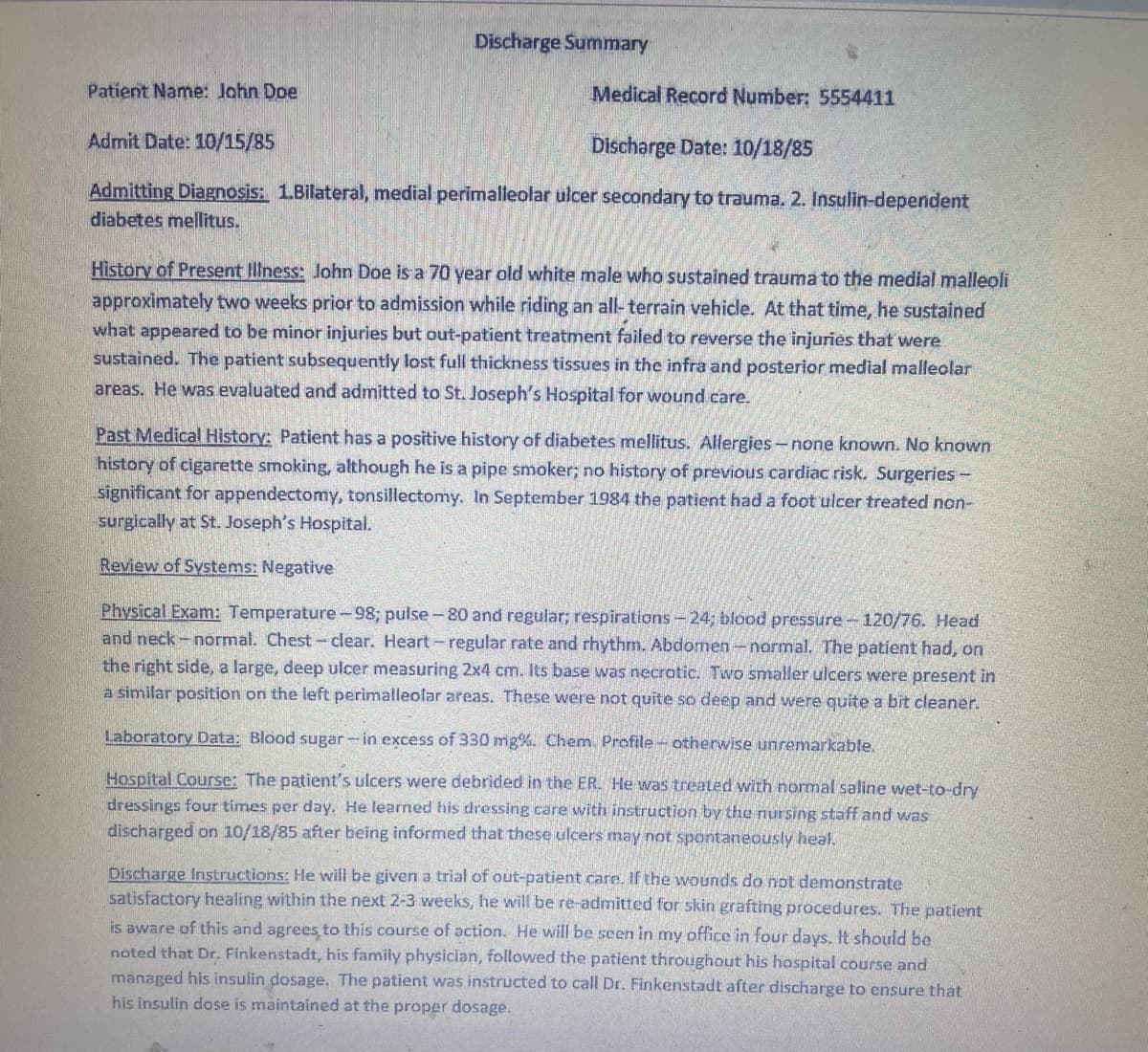4. How many ulcers did the patient have and what were the size and locations of the ulcers? 5. What type of dressings was the patient treated with? 6. If the patient's wounds do not heal within the next 2-3 weeks, what will be the next procedure the physician will perform?
4. How many ulcers did the patient have and what were the size and locations of the ulcers? 5. What type of dressings was the patient treated with? 6. If the patient's wounds do not heal within the next 2-3 weeks, what will be the next procedure the physician will perform?
Phlebotomy Essentials
6th Edition
ISBN:9781451194524
Author:Ruth McCall, Cathee M. Tankersley MT(ASCP)
Publisher:Ruth McCall, Cathee M. Tankersley MT(ASCP)
Chapter1: Phlebotomy: Past And Present And The Healthcare Setting
Section: Chapter Questions
Problem 1SRQ
Related questions
Question
4. How many ulcers did the patient have and what were the size and locations of the ulcers? 5. What type of dressings was the patient treated with?
6. If the patient's wounds do not heal within the next 2-3 weeks, what will be the next procedure the physician will perform?

Transcribed Image Text:Discharge Summary
Patient Name: John Doe
Medical Record Number: 5554411
Admit Date: 10/15/85
Discharge Date: 10/18/85
Admitting Diagnosis: 1.Bilateral, medial perimalleolar ulcer secondary to trauma. 2. Insulin-dependent
diabetes mellitus.
History of Present Illness: John Doe is a 70 year old white male who sustained trauma to the medial malleoli
approximately two weeks prior to admission while riding an all-terrain vehicle. At that time, he sustained
what appeared to be minor injuries but out-patient treatment failed to reverse the injuries that were
sustained. The patient subsequently lost full thickness tissues in the infra and posterior medial malleolar
areas. He was evaluated and admitted to St. Joseph's Hospital for wound care.
Past Medical History: Patient has a positive history of diabetes mellitus. Allergies-none known. No known
history of cigarette smoking, although he is a pipe smoker; no history of previous cardiac risk. Surgeries -
significant for appendectomy, tonsillectomy. In September 1984 the patient had a foot ulcer treated non-
surgically at St. Joseph's Hospital.
Review of Systems: Negative
Physical Exam: Temperature-98; pulse-80 and regular; respirations-24; blood pressure-120/76. Head
and neck-normal. Chest-clear. Heart-regular rate and rhythm. Abdomen - normal. The patient had, on
the right side, a large, deep ulcer measuring 2x4 cm. Its base was necrotic. Two smaller ulcers were present in
a similar position on the left perimalleolar areas. These were not quite so deep and were quite a bit cleaner.
Laboratory Data: Blood sugar-in excess of 330 mg%. Chem. Profile - otherwise unremarkable.
Hospital Course: The patient's ulcers were debrided in the ER. He was treated with normal saline wet-to-dry
dressings four times per day. He learned his dressing care with instruction by the nursing staff and was
discharged on 10/18/85 after being informed that these ulcers may not spontaneously heal.
Discharge Instructions: He will be given a trial of out-patient care. If the wounds do not demonstrate
satisfactory healing within the next 2-3 weeks, he will be re-admitted for skin grafting procedures. The patient
is aware of this and agrees to this course of action. He will be seen in my office in four days. It should be
noted that Dr. Finkenstadt, his family physician, followed the patient throughout his hospital course and
managed his insulin dosage. The patient was instructed to call Dr. Finkenstadt after discharge to ensure that
his insulin dose is maintained at the proper dosage.
Expert Solution
This question has been solved!
Explore an expertly crafted, step-by-step solution for a thorough understanding of key concepts.
This is a popular solution!
Trending now
This is a popular solution!
Step by step
Solved in 2 steps

Recommended textbooks for you

Phlebotomy Essentials
Nursing
ISBN:
9781451194524
Author:
Ruth McCall, Cathee M. Tankersley MT(ASCP)
Publisher:
JONES+BARTLETT PUBLISHERS, INC.

Gould's Pathophysiology for the Health Profession…
Nursing
ISBN:
9780323414425
Author:
Robert J Hubert BS
Publisher:
Saunders

Fundamentals Of Nursing
Nursing
ISBN:
9781496362179
Author:
Taylor, Carol (carol R.), LYNN, Pamela (pamela Barbara), Bartlett, Jennifer L.
Publisher:
Wolters Kluwer,

Phlebotomy Essentials
Nursing
ISBN:
9781451194524
Author:
Ruth McCall, Cathee M. Tankersley MT(ASCP)
Publisher:
JONES+BARTLETT PUBLISHERS, INC.

Gould's Pathophysiology for the Health Profession…
Nursing
ISBN:
9780323414425
Author:
Robert J Hubert BS
Publisher:
Saunders

Fundamentals Of Nursing
Nursing
ISBN:
9781496362179
Author:
Taylor, Carol (carol R.), LYNN, Pamela (pamela Barbara), Bartlett, Jennifer L.
Publisher:
Wolters Kluwer,

Fundamentals of Nursing, 9e
Nursing
ISBN:
9780323327404
Author:
Patricia A. Potter RN MSN PhD FAAN, Anne Griffin Perry RN EdD FAAN, Patricia Stockert RN BSN MS PhD, Amy Hall RN BSN MS PhD CNE
Publisher:
Elsevier Science

Study Guide for Gould's Pathophysiology for the H…
Nursing
ISBN:
9780323414142
Author:
Hubert BS, Robert J; VanMeter PhD, Karin C.
Publisher:
Saunders

Issues and Ethics in the Helping Professions (Min…
Nursing
ISBN:
9781337406291
Author:
Gerald Corey, Marianne Schneider Corey, Cindy Corey
Publisher:
Cengage Learning